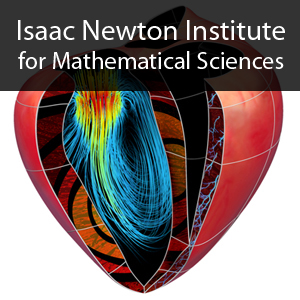Modeling of cardiac Ischemia in human myocytes and tissue including spatiotemporal electrophysiological variations
Duration: 15 mins 58 secs
Share this media item:
Embed this media item:
Embed this media item:
About this item

| Description: |
Seemann, G (Karlsruhe (TH))
Thursday 23 July 2009, 16:00-16:15 |
|---|
| Created: | 2009-07-27 13:19 | ||
|---|---|---|---|
| Collection: | Cardiac Physiome Project | ||
| Publisher: | Isaac Newton Institute | ||
| Copyright: | Seemann, G (Karlsruhe (TH)) | ||
| Language: | eng (English) | ||
| Credits: |
|
||
| Abstract: | Cardiac tissue exhibits spatially heterogeneous electrophysiological properties. In cardiac diseases, these properties change also in time. This study introduces a framework to investigate their role in cardiac ischemia using mathematical modeling and computational simulations at cellular and tissue level. Ischemia was incorporated by reproducing effects of hyperkalemia, acidosis, and hypoxia with a human electrophysiological model. In tissue, spatial heterogeneous ischemia was described by central ischemic (CIZ) and border zone. Anisotropic conduction was simulated with a bidomain approach in an anatomical ventricle model including realistic fiber orientation and transmural, apico-basal, and interventricular electrophysiological heterogeneities. A model of electrical conductivity in a human torso served for ECG calculations. Ischemia raised resting but reduced peak voltage, action potential duration and upstroke velocity. These effects were strongest in subepicardial cells. In tissue, conduction velocity decreased towards CIZ but effective refractory period increases. At 10 min of ischemia 19% of subepi- and 100% of subendocardial CIZ cells activated with a delay of 34.6±7.8 ms and 55.9±18.8 ms, respectively, compared to normal. Significant ST elevation and premature T wave end appeared only with the subepicardial CIZ. The model reproduced effects of ischemia at cellular and tissue level. The results suggest that the presented in-silico approach can complement experimental studies e.g. in understanding the role of ischemia or the onset of arrhythmia. |
|---|---|
Available Formats
| Format | Quality | Bitrate | Size | |||
|---|---|---|---|---|---|---|
| MPEG-4 Video | 480x360 | 1.82 Mbits/sec | 219.01 MB | View | Download | |
| WebM | 450x360 | 612.26 kbits/sec | 70.93 MB | View | Download | |
| Flash Video | 480x360 | 805.27 kbits/sec | 93.78 MB | View | Download | |
| iPod Video | 320x240 | 504.42 kbits/sec | 58.74 MB | View | Download | |
| QuickTime | 480x360 | 506.58 kbits/sec | 58.99 MB | View | Download | |
| MP3 | 44100 Hz | 125.0 kbits/sec | 14.36 MB | Listen | Download | |
| Windows Media Video | 478.68 kbits/sec | 55.75 MB | View | Download | ||
| Auto * | (Allows browser to choose a format it supports) | |||||

